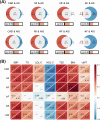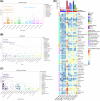Identification of shared genetic etiology of cardiovascular and cerebrovascular diseases through common cardiometabolic risk factors
- PMID: 39730871
- PMCID: PMC11680921
- DOI: 10.1038/s42003-024-07417-6
Identification of shared genetic etiology of cardiovascular and cerebrovascular diseases through common cardiometabolic risk factors
Abstract
Cardiovascular diseases (CVDs) and cerebrovascular diseases (CeVDs) are closely related vascular diseases, sharing common cardiometabolic risk factors (RFs). Although pleiotropic genetic variants of these two diseases have been reported, their underlying pathological mechanisms are still unclear. Leveraging GWAS summary data and using genetic correlation, pleiotropic variants identification, and colocalization analyses, we identified 11 colocalized loci for CVDs-CeVDs-BP (blood pressure), CVDs-CeVDs-LIP (lipid traits), and CVDs-CeVDs-cIMT (carotid intima-media thickness) triplets. No shared causal loci were found for CVDs-CeVDs-T2D (type 2 diabetes) or CVDs-CeVDs-BMI (body mass index) triplets. The 11 loci were mapped to 12 genes, namely CASZ1, CDKN1A, TWIST1, CDKN2B, ABO, SWAP70, SH2B3, LRCH1, FES, GOSR2, RPRML, and LDLR, where both GOSR2 and RPRML were mapped to one locus. They were enriched in pathways related to cellular response to external stimulus and regulation of the phosphate metabolic process and were highly expressed in endothelial cells, epithelial cells, and smooth muscle cells. Multi-omics analysis revealed methylation of two genes (CASZ1 and LRCH1) may play a causal role in the genetic pleiotropy. Notably, these pleiotropic loci are highly enriched in the targets of antihypertensive drugs, which further emphasizes the role of the blood pressure regulation pathway in the shared etiology of CVDs and CeVDs.
© 2024. The Author(s).
Conflict of interest statement
Competing interests: The authors declare no competing interests.
Figures






Similar articles
-
Identification of novel variants associated with osteoporosis, type 2 diabetes and potentially pleiotropic loci using pleiotropic cFDR method.Bone. 2018 Dec;117:6-14. doi: 10.1016/j.bone.2018.08.020. Epub 2018 Aug 30. Bone. 2018. PMID: 30172742 Free PMC article.
-
Multivariate Genome-wide Association Analysis of a Cytokine Network Reveals Variants with Widespread Immune, Haematological, and Cardiometabolic Pleiotropy.Am J Hum Genet. 2019 Dec 5;105(6):1076-1090. doi: 10.1016/j.ajhg.2019.10.001. Epub 2019 Oct 31. Am J Hum Genet. 2019. PMID: 31679650 Free PMC article.
-
Multi-trait association studies discover pleiotropic loci between Alzheimer's disease and cardiometabolic traits.Alzheimers Res Ther. 2021 Feb 4;13(1):34. doi: 10.1186/s13195-021-00773-z. Alzheimers Res Ther. 2021. PMID: 33541420 Free PMC article.
-
Differences in the prevention and control of cardiovascular and cerebrovascular diseases.Pharmacol Res. 2021 Aug;170:105737. doi: 10.1016/j.phrs.2021.105737. Epub 2021 Jun 18. Pharmacol Res. 2021. PMID: 34147660 Review.
-
Knowledge-based analysis of genetic associations of rheumatoid arthritis to inform studies searching for pleiotropic genes: a literature review and network analysis.Arthritis Res Ther. 2015 Aug 8;17(1):202. doi: 10.1186/s13075-015-0715-1. Arthritis Res Ther. 2015. PMID: 26253105 Free PMC article. Review.
References
-
- Organization, W. H. Cardiovascular Diseases (CVDs) Fact Sheethttps://www.who.int/health-topics/cardiovascular-diseases#tab=tab_1.
-
- Heart Research Institute, N. Cardiovascular Disease: Impacts and Riskshttps://www.hri.org.nz/health/learn/cardiovascular-disease/cardiovascula....
-
- Gallacher, K. I., Jani, B. D., Hanlon, P., Nicholl, B. I. & Mair, F. S. Multimorbidity in stroke. Stroke50, 1919–1926 (2019). - PubMed
MeSH terms
Grants and funding
LinkOut - more resources
Full Text Sources
Miscellaneous

